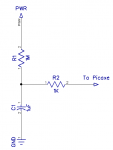I tried searching the forum for 'nap' and came up empty. I suppose it's not much used.
'Nap' is not implemented on an x2 and so I'm looking for an alternative which will take me to ultra-low power for a period of one second, wake up to take some readings, and then back to sleep. This will be repeated indefinitely on my remote trying to conserve as much battery as possible. Ideally, it would also include 'disablebod' for additional savings.
I can use 'sleep', but that can't get me down to the second increments I would like to use.
Anyone have suggestions for the best way to implement that?
I was hoping to use an interrupt wakeup supplied by my radio being activated by the master module which has an RTC. But the radio sits on the hser pins (c.6 and c.7) which don't do interrupts ... darn. Adding an RTC to the remote would seem to negate power savings I could achieve by a short, deep, sleep. I've found a very low power one (PCF85263A) which might do if I can't come up with an alternate solution. But that also means I'd have to alter my PCB.
Suggestions welcome.
'Nap' is not implemented on an x2 and so I'm looking for an alternative which will take me to ultra-low power for a period of one second, wake up to take some readings, and then back to sleep. This will be repeated indefinitely on my remote trying to conserve as much battery as possible. Ideally, it would also include 'disablebod' for additional savings.
I can use 'sleep', but that can't get me down to the second increments I would like to use.
Anyone have suggestions for the best way to implement that?
I was hoping to use an interrupt wakeup supplied by my radio being activated by the master module which has an RTC. But the radio sits on the hser pins (c.6 and c.7) which don't do interrupts ... darn. Adding an RTC to the remote would seem to negate power savings I could achieve by a short, deep, sleep. I've found a very low power one (PCF85263A) which might do if I can't come up with an alternate solution. But that also means I'd have to alter my PCB.
Suggestions welcome.

